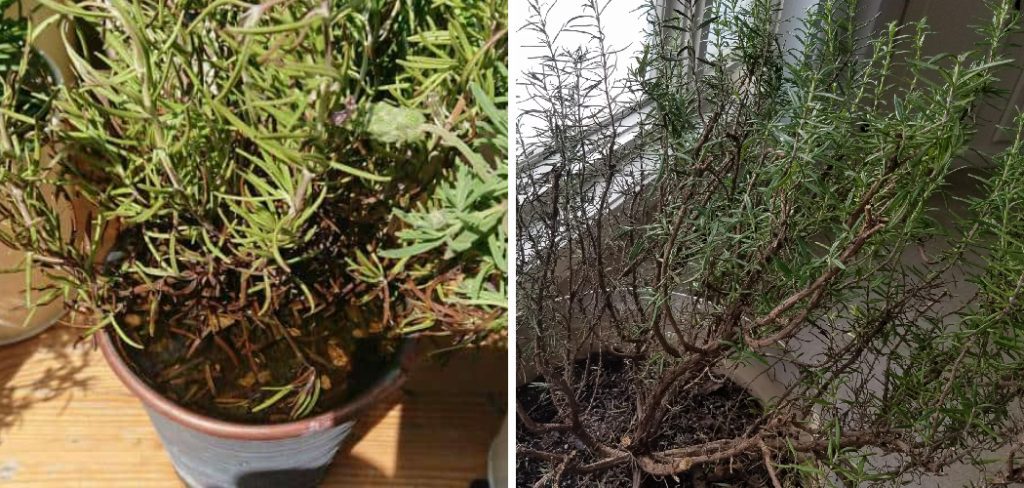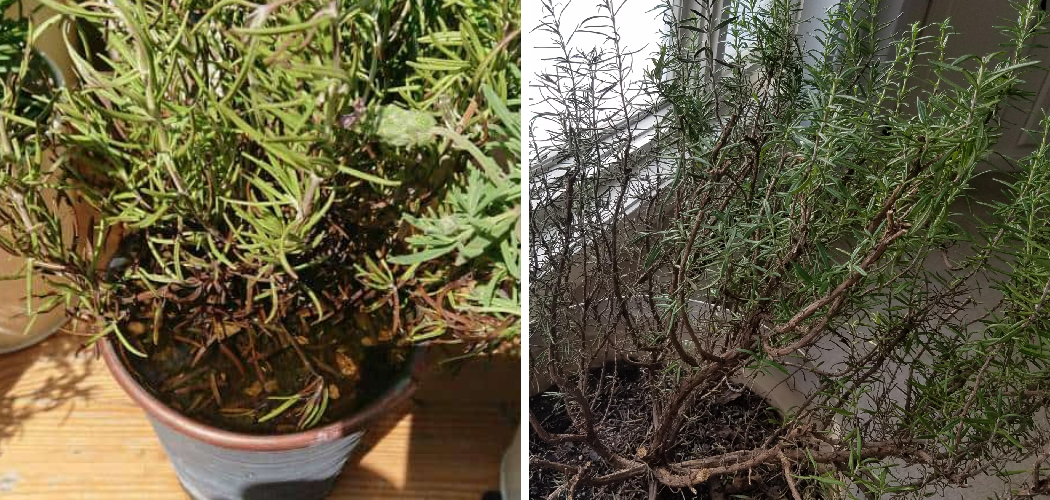Rosemary is dying can be determined by signs such as wilting leaves, yellowing foliage, and stem discoloration. If you notice these symptoms, your rosemary plant may be in decline.

How to Know If Rosemary is Dying : Step by Step Guide
Recognizing Physical Symptoms
If you notice yellowing or browning leaves on your rosemary plant, it could be a sign that it is dying. This discoloration may start at the tips of the leaves and gradually spread throughout the plant. Another physical symptom to look out for is wilted or drooping stems.
These can be a sign of dehydration, which may occur if the plant is not receiving enough water. Additionally, if you notice reduced growth or a stunted appearance in your rosemary plant, it could indicate that it is not getting the proper nutrients or conditions it needs to thrive. It is important to regularly inspect your plant and address any signs of distress promptly to help ensure its health and vitality.
Credit: gardening.stackexchange.com
Evaluating The Soil And Environment
Assessing the soil moisture levels is crucial in determining if your rosemary plant is dying. Proper moisture is essential for plant growth, and if the soil is too dry or too wet, it can lead to wilting or root rot. To check the moisture levels, gently insert your finger into the soil up to the first knuckle. If the soil feels dry, it’s an indication that the plant needs watering. On the other hand, if the soil feels excessively wet or waterlogged, you may need to improve drainage by amending the soil or adjusting the amount of watering.
In addition to moisture, evaluating soil quality and pH levels is important. Rosemary thrives in well-draining soil with a pH range of 6 to 7.5. You can assess soil quality by examining its texture. Sandy soil may drain too quickly, while heavy clay soil can retain water, both of which are unfavorable for rosemary. Conducting a soil test to determine pH levels can help you adjust the soil’s acidity or alkalinity if necessary.
Sunlight exposure and proper placement are also factors to consider. Rosemary prefers full sun, which means it requires at least 6-8 hours of direct sunlight daily. If your plant is not receiving enough sunlight, it may exhibit signs of stress or decline. Ensure the plant is placed in a location with adequate light and consider adjusting its position if needed.
Identifying Pest Or Disease Infestations
Identifying pest infestations is crucial in determining if your rosemary plant is suffering. There are common pests that can affect rosemary, including aphids, spider mites, and whiteflies. Aphids are small insects that can be green, black, or brown and may cluster on the leaves. Spider mites are tiny pests that can cause yellowing and stippling on the foliage, and you may notice webbing between the branches. Whiteflies are small and white insects that fly around the plant when disturbed.
Signs of pest damage can vary depending on the type of pest. Look for curled leaves, yellowing foliage, distorted growth, or sticky residue on the leaves caused by honeydew excreted by pests. Chewing damage or discoloration on the leaves may also be indicators. Treating and preventing pest infestations can be done through several methods, including using insecticidal soaps, neem oil, or introducing natural predators to the garden. Regularly inspecting your rosemary plant and maintaining a healthy growing environment can help prevent pests from infesting your plant.
Troubleshooting Watering Issues
Troubleshooting watering issues:
Proper watering is crucial for the health of rosemary plants. To understand the importance of proper watering, it is essential to recognize the signs of overwatering and underwatering.
Detecting signs of overwatering:
Overwatering can lead to root rot and ultimately cause rosemary to die. To identify if your rosemary is suffering from overwatering, look out for wilted leaves, yellowing foliage, and a damp and smelly soil. Additionally, you may notice a decline in overall plant growth and an increased susceptibility to diseases.
Recognizing symptoms of underwatering:
Underwatering can stress the rosemary plant and result in drying out. Signs of underwatering include drooping leaves, browning foliage, and a dry and parched soil. Moreover, the plant may exhibit reduced vigor and become more susceptible to pests and diseases.
Factors Affecting Rosemary Health
| Factors affecting rosemary health |
|---|
|
Rosemary health can be impacted by various factors, including temperature, climate, pruning and care, as well as nutrient deficiencies. Temperature and climate play a significant role in the well-being of rosemary plants. Extreme temperatures, whether too hot or too cold, can stress the plant and lead to decline or death. Improper pruning and care practices can also have detrimental effects on rosemary health. Neglecting to prune regularly can result in a dense, woody growth that inhibits airflow and makes the plant susceptible to diseases. In addition, improper watering and fertilization can lead to nutrient deficiencies, affecting the overall health of rosemary. It’s important to provide the right balance of nutrients and water to ensure optimal growth and prevent the plant from dying prematurely. |
Implementing Care And Rehabilitation Techniques
Implementing care and rehabilitation techniques is essential to revive a dying rosemary plant. Pruning techniques play a crucial role in restoring its health. Start by removing any dead or damaged branches, ensuring you use sharp, clean pruning shears for a clean cut. Adjusting watering practices is another vital step, as overwatering can lead to root rot. It is essential to allow the soil to dry out between waterings but ensure the plant never becomes completely dry.
Proper fertilization is key to providing the necessary nutrients for recovery. Opt for a balanced fertilizer and follow the manufacturer’s instructions for application. Consider supplementing with organic matter, such as compost, to improve soil health. With these care techniques, you can support the revival of your rosemary plant and promote its optimal growth.
Preventing Future Problems And Maintaining Healthy Rosemary
Ensuring the health and vitality of your rosemary plant is crucial for its longevity. By following best practices, you can prevent future problems and maintain the wellbeing of your rosemary:
Best practices for preventing pest infestations
- Regularly inspect: Conduct regular inspections to identify any signs of pest infestations early on.
- Natural deterrents: Use natural deterrents such as neem oil or insecticidal soap to ward off pests.
- Companion planting: Utilize companion plants like marigolds or lavender, which repel pests.
- Clean surroundings: Maintain cleanliness in the surrounding area to discourage pest attraction.
Creating an ideal growing environment
- Sunlight: Ensure your rosemary receives 6-8 hours of direct sunlight daily.
- Well-draining soil: Plant rosemary in well-draining soil to prevent root rot.
- Adequate watering: Water when the top inch of soil is dry, avoiding excessive moisture.
- Proper spacing: Space plants adequately to improve air circulation and prevent disease.
Regular maintenance routines for sustained plant health
- Pruning: Regularly pruning your rosemary plant promotes growth and prevents overcrowding.
- Annual repotting: Repot your rosemary annually, providing fresh soil and nutrients.
- Fertilization: Apply a balanced organic fertilizer during the growing season to enhance plant health.
Frequently Asked Questions Of How To Know If Rosemary Is Dying
What Does Dying Rosemary Look Like?
Dying rosemary appears with yellow or brown leaves and a lack of growth or wilting.
How Do You Fix Rosemary That Is Dying?
To fix a dying rosemary plant, ensure it receives ample sunlight and well-drained soil. Water it regularly, but avoid overwatering. Trim dead branches and pruned parts to promote new growth. Keep pests away by using organic insecticides.
Will Rosemary Grow Back After Dying?
Yes, rosemary can grow back after dying, allowing you to revive and enjoy its aromatic presence again.
How Can You Tell If Rosemary Is Bad?
Bad rosemary can be identified by its faded color, wilted leaves, and a strong, unpleasant smell.
Conclusion
Identifying whether or not your rosemary plant is dying is crucial for ensuring its health and longevity. By paying attention to the physical appearance of the plant, such as yellowing leaves, weak stems, and lack of new growth, you can quickly assess the plant’s condition.
Remember to consider environmental factors like temperature, sunlight, and watering needs to provide optimal care. Regularly inspecting for signs of pests and diseases, such as discoloration or wilting, is also essential. Taking immediate action by adjusting the watering schedule, providing proper nutrients, or treating the plant for diseases can help revive a dying rosemary plant.
With care and attention to the specific needs of rosemary, you can ensure its continued growth and enjoy the aromatic benefits it brings to your garden or kitchen.

